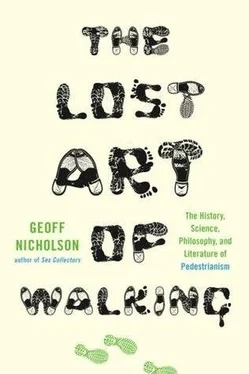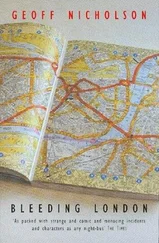My mother died a short while later, quickly it appears, and although there must have been some pain, it couldn’t have been prolonged. She died trying to get up from the armchair in her living room. She never quite made it. She got halfway, struggled, and fell back awkwardly, half in the chair, half against the radiator beside her, where she was found the next morning by a neighbor.
I was a long way from England when she died, and I’m told it would have done no good even if I, or anyone, had been in the same room at the time. There was nothing anybody could have done. The doctors told me this sort of thing just happens. Damaged hearts like my mother’s sometimes simply stop working. So, to be absolutely correct, the walk up Gleadless Road hadn’t in itself killed my mother, but the sudden overexertion had been enough to cause undue wear on some vital part of her system, a part that would later give up the ghost.
I was wandering and walking through the deserts of Arizona at the time of her death. You might imagine you’d feel some psychic twinge, receive some supernatural message of disconnection when your mother dies, but I received nothing. I flew home a week or so later, with no reason to think that my mother wasn’t alive, and found a phone message from my uncle, which was odd, and if you thought about it, only likely to mean one thing. But even so it took me some time to put two and two together.
I tried to think where I’d been at the time of my mother’s death. I worked out that I was in a motel on the outskirts of Tucson, my morning, my mother’s evening, and I would have been planning the details of a day’s walk in the Organ Pipe Cactus National Monument in the Sonoran Desert. While her body was lying slumped in the chair I was enjoying a good though apparently unexceptional day’s walking.
Now, a good decade after my mother’s death, I was going to walk up Gleadless Road, the hill that killed my mother. I left Steve’s house and made my way to the bottom of the hill and, frankly, from that vantage point, it didn’t look so steep after all. Perhaps my mother, and my memory, had exaggerated: maybe the hill wasn’t so scary, maybe it hadn’t affected her so badly after all. I began my walk.
There was a sidewalk going up on either side of the hill and I tried to think which one my mother would have chosen for her ascent. To the left of the road was a wooded area and a flat, open, grassy expanse. On the other side were houses in rows that ran across the hillside at right angles from the road. This was the Gleadless Valley Estate, a public housing development that had once had a reputation for being the best in Europe, and had won all sorts of architectural awards from people who didn’t live in public housing. I felt pretty sure my mother would have chosen this more built-up side. The houses provided a little protection, some shelter from the wind, and in places there were steps and a handrail. If you were making your way up here in a blizzard you’d be grateful for those things.
And as I went on, I realized the hill was every bit as steep as I’d previously thought. It was a cool day in September and I had on just a light jacket, but before I was halfway up the hill I was sweating and panting like a hog. I was impressed that my mother had made it at all. By the time I got to the top, which was still some way from where my mother actually lived — she’d have had another thirty-minute walk before she got home — I was in absolute awe of her determination and tenacity, amazed that she’d had the strength and the legs and the guts to keep going. What a strong, brave, game old lady she’d been. It even occurred to me as I gritted my way upward, feeling my temperature and heartbeat rise, the blood rushing into my face, sweat breaking out on my forehead, that the God of Ironic Deaths might find it amusing to strike me down with a heart attack right there and then as I walked. He didn’t. Evidently he’s biding his time.
At the top of the hill I stopped, turned around, and went down again, walking back this time through part of the Gleadless Valley Estate. It looked rougher than Longley, despite its awards. There was more graffiti, more broken and barred windows, more litter, some smashed bottles here and there. When I got back to the house Steve asked me how my walk was.
‘It damn near killed me’, I said, and he probably thought I was joking.
10. Perfect and Imperfect Walks, Last Walks, the Walks We Didn’t Take
In the course of my walking life I’ve often wondered if there’s any such thing as a perfect walk, in the way that there’s a perfect storm, a perfect wave, or a perfect inning — the one walk that is utterly different from all the other walks we’ll ever take in our lives, a walk that is personal and universal, that makes a giant leap from the ordinary to the extraordinary, a walk that is everything you ever wanted a walk to be and yet is something more than that, too.
Being the first person ever to set foot on some piece of terra incognita would surely have a kind of perfection about it. Inevitably, it’s an option that’s denied to the vast majority of us — walking in fresh snow or on fresh sand is as close as most of us will ever get — and perhaps we’re lucky, since perfect or not, a great deal of bitterness and conflict can come out of this kind of exploration.
Matthew A. Henson is now widely considered to be the first American ever to have set foot on the North Pole. In 1909 he was part of an expedition led by Commander Robert Peary. This was Peary’s eighth such attempt, and along the way he fell ill and became unable to walk. As they neared their goal Henson was regularly sent ahead on foot as a scout while Peary continued on a dog sled, tended by four Eskimo guides.
Thus, by definition, Peary wasn’t ever going to be the first man to walk on, much less walk to, the North Pole. Henson inevitably got there first. Nevertheless, Peary wanted all the credit for himself and he wanted Henson to have none. Henson writes:
‘From the time we knew we were at the Pole, Commander Peary scarcely spoke to me.’
I have just the very slightest sympathy with Peary. Henson was a great man to have with you, no doubt, but he didn’t conceive of the expedition, didn’t organize it, finance it, or lead it. Whether Peary was justified in regarding Henson as at best an employee, probably more as a servant, is another matter. Completely unjustifiable was the rage Peary expressed when Henson wrote his own account of events in his book A Negro Explorer at the North Pole . Yes, the first American to set foot on the North Pole was black, and only long after the event did he receive his due. It wasn’t until 1944 that Congress gave him a duplicate of the silver medal they’d awarded to Peary decades earlier. The four Eskimos remain undecorated.
Recently, the author Robert Bryce has claimed that nobody on the Peary expedition got within a hundred miles of the Pole. He has, unsurprisingly, been denounced in certain quarters as a racist.
♦
Things were less racially charged at the South Pole, if only because the notion of a racially integrated expedition was unimaginable to its explorers. A Frenchman, Jules-Sebastien-Cesar Dumont d’Urville, was the first man to set foot on Antarctica, and Roald Amundsen, a Norwegian, was the first man to walk to the South Pole, shortly followed, though not literally, by the Englishman Robert Scott.
Amundsen’s description of walking across an area he named the Devil’s Ballroom gives some idea of his chilly Scandinavian stoicism. ‘Our walk across this frozen lake was not pleasant. The ground under our feet was evidently hollow, and it sounded as if we were walking on empty barrels. First a man fell through, then a couple of dogs — but they got up again all right’. Insouciance is certainly part of the perfect walk, I think.
Читать дальше












